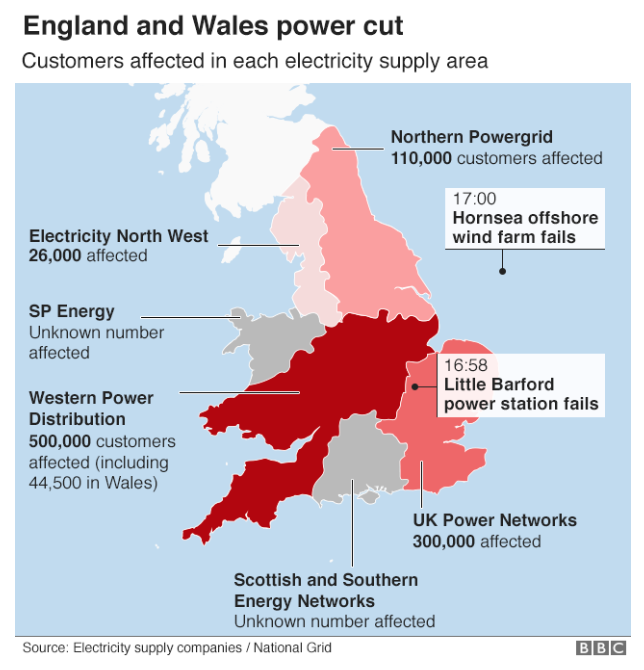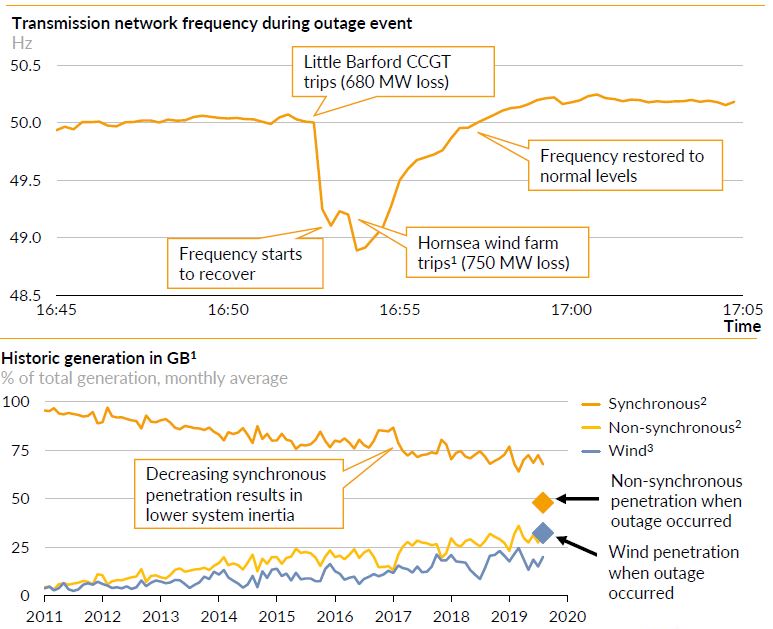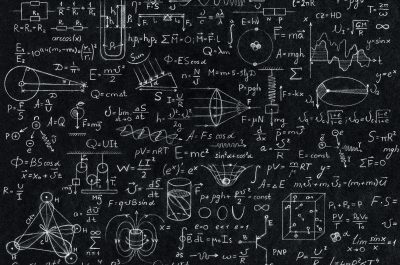Blackout UK – who’s to blame?
At about 5pm last Friday as Brits were winding up work for the week and about to head home, an extreme event shocked the UK’s energy system causing widespread power cuts.
Scenes from the country’s worst blackout in a more than a decade were reportedly “reminiscent of a darkly apocalyptic Hollywood film”[1]. Passengers were stranded on trains and at airports, chaos ensued on the roads and almost a million homes lost power.
While the system was restored by 5.40pm[2], the significant knock-on impact from the 40-minute event continued through the evening and has left many questions to be answered.
What do we know so far?
This was a “rare and unusual” event, according to National Grid, as two large power plants “near-simultaneously” went offline, disconnecting from the grid[3]. A 740MW gas-fired power station at Little Barford, Bedfordshire, failed at 4.58pm followed by the Hornsea offshore wind farm also disconnecting from the grid. The graph below shows the frequency starting to recover after the Little Barford trip, but then falling again when Hornsea went off.
The exact timing is unclear and it is a critical point. The UK grid is meant to be able to withstand a 1GW trip, so the 740MW Little Barford outage alone shouldn’t have decreased the frequency by as much as it appears to have. Together the two stations account for about 5 per cent of the UK’s electricity and power needs so their loss caused a major drop in the grid’s frequency[4].
Strong winds at the time led to exceptionally high volumes of renewable power which also meant fewer thermal plants were generating. Less thermal generation reduces inertia in the system which makes it less stable and able to cope with sudden frequency drops.
Figure 1: Aurora Energy Research’s initial thoughts and analysis on the GB power outages on 9th August[6]
What is frequency?Generation must exactly match demand to keep frequency stable. Think of water in a pipe. The pressure of the water in the pipe is like frequency in the electricity system. The pressure must be kept constant. If there is more water (generation) than is needed for demand then the pressure (frequency) increases. If there’s not enough water flowing in the pipe to meet demand then the pressure drops. It is the job of the market operator to maintain the frequency of the power supply close to 50hz in order to keep the electricity system stable. A variation in frequency of more than one per cent in either direction is enough to cause parts of the energy system to shut down. In the UK the market operator is National Grid, in Australia it is the Australian Energy Market Operator (AEMO). |
What is inertia?Inertia in the energy system refers to the continuous momentum of energy typically provided by the large spinning turbines of synchronous generators like large coal-fired power stations. This type of generation helps withstand changes in generation output and load levels to keep the system stable. Intertia is a bit like a truck travelling at 80km/h – when it hits an incline or decline it holds its speed for quite a while before adjustments need to be made. With the retirement of many coal power plants and more renewable generation coming into the system, there will be less inertia available and we therefore need to find flexibility elsewhere in the system to back it up. [5] |
What is the rate of change of frequency?The rate of change of frequency (ROCOF) is inversely related to the amount of inertia available in the grid. When the level of inertia is low, the impact of a drop in frequency is high. While a technical point, it’s an important one to understand and may be a factor that contributed to the UK event when the generators went offline and frequency quickly dropped to 48.9hz, well below tolerance boundaries. |
The market operator’s response
Duncan Burt, Director of Operations at National Grid, said normal protective systems reacted automatically when the two generators went offline causing the frequency fall, but the loss was so large that secondary systems were activated. These automatic secondary protection systems fire very quickly to remove electricity demand on local networks in order to keep the rest of the system stable[7] (see Figure 2 below).

Figure 2: Customers affected by power cuts on 9 August 2019 (Source: BBC)
The transport sector in the UK was hardest hit by the outages with railways, roads and airports thrown into chaos. Rail passengers report being stuck on stations in darkness or on trains for hours with no light, water or toilets. The power was cut at major stations including King’s Cross and St Pancras in London and other stations like Euston were forced to close because of exceptionally high passenger numbers[8]. Boards at Waterloo showed no trains departing on any platforms[9].
Newcastle airport lost power for about 15 minutes with people using their mobile phones as torches to move around the terminal. Ipswich Hospital lost power for 30 minutes when its back-up generator failed to start. Hospital staff helped keep patients safe in complete darkness with alarms going off[10].
Lessons learned
Ofgem has demanded an initial report from National Grid by the end of this week to explain what went wrong. The government has also announced an investigation by the Energy Emergencies Executive Committee to look at what happened and consider whether the procedures followed by National Grid are fit for purpose[11].
National Grid has stated it will cooperate fully and has been working to understand the exact sequence of events and consequences. Some of the questions to be answered include[12]:
- Why did two generators fail almost simultaneously?
- Was there any link with greater use of renewables on the network (National Grid doesn’t at this stage believe that was the case)?
- Why did the failure of two generators cause such disruption?
- Why, when there was a limited outage, was the national rail network impacted so severely?
- What are the lessons?
Questions raised by others in the energy sector include whether more integration and coordination between the transmission and distribution networks could allow for a more surgical approach[13] to load shedding. How do we better protect and prepare critical infrastructure like hospitals, airports, signalling systems and transport networks for times when these events will inevitably happen again? What role can batteries and synthetic inertia play and how might this best be integrated into the evolving grid?
Possibly most challenging – if significant changes are required, how much are they going to cost?
Food for thought for Australia
While we don’t yet know the cause of why two power plants failed at almost the same time, we do know that getting more flexibility into the system needs to be carefully considered both in the UK and here in Australia. We already have some of the highest levels of solar integration in the world and the supply of renewable energy to our grid continues to grow.
The UK event happened in the same week the Australian Energy Regulator here in Australia started legal action against four wind farms relating to their ride-through settings on the day of the SA system black event in 2016. Did the relevant settings on the Hornsea wind farm have anything to do with it tripping?
Friday’s event was a stark reminder of how critical energy can be to everyday life and how we need to carefully plan our transition to the grid of the future.
[1] https://www.telegraph.co.uk/news/09/major-power-cut-across-country-london-goes-dark-national-grid/
[2] https://www.theguardian.com/business/2019/aug/12/what-are-the-questions-are-raised-by-the-uks-recent-blackout
[3] https://www.bbc.com/news/uk-49302996 Duncan Burt, Director of Operations on BBC TV.
[5] For a further non-technical explanation of inertia, frequency and system strength, see https://www.electranet.com.au/wp-content/uploads/2019-02-18-System-Strength-Economic-Evaluation-Report-FINAL.pdf pp.9-10

